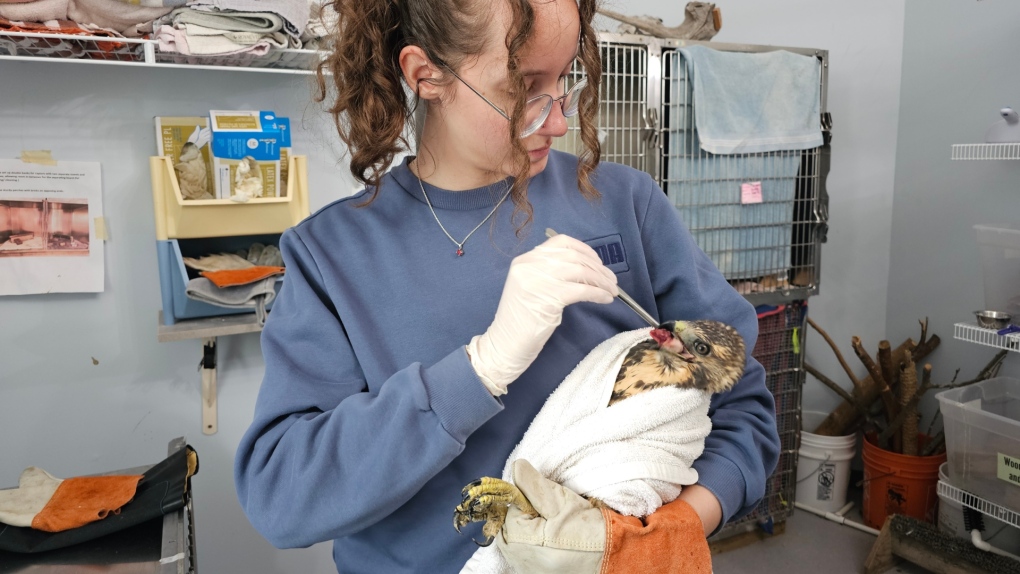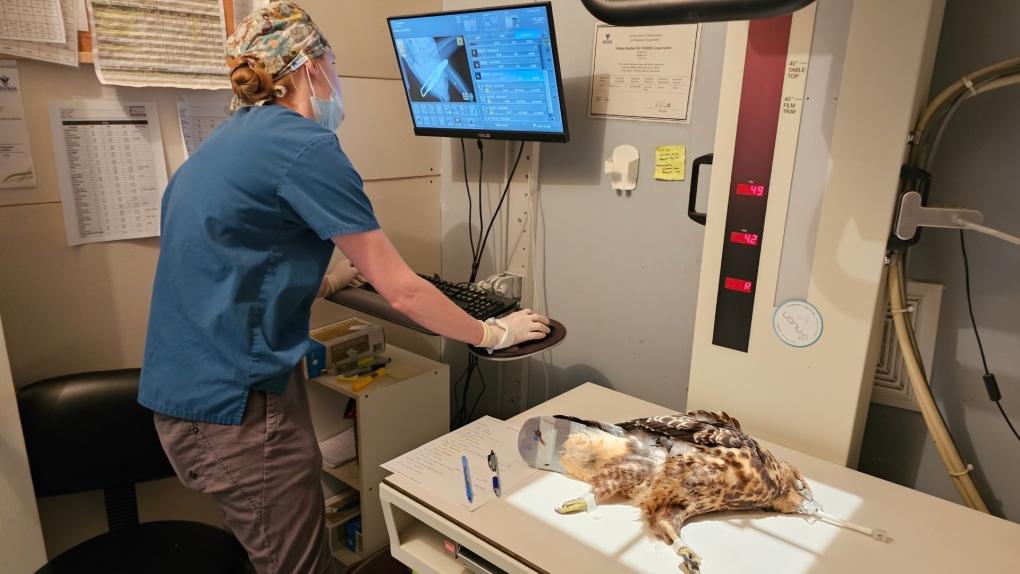Alberta wildlife facility sees influx of injured hawks; what you can do to help
A wildlife rehabilitation facility in southern Alberta is looking for help after becoming inundated with injured hawks.
The Alberta Institute for Wildlife Conservation (AIWC) in the hamlet of Madden has admitted more than 50 hawks since August.
"A lot of them are coming in with impact trauma after being hit by car, which means we're seeing really big injuries," said Raelee Barth, AWIC operations manager.
"We'll see is a drooping wing where they can't even stand, we're finding broken bones in the wings, in the legs, in the shoulder girdle."
Barth says the team have seen a variety of hawks including red-tailed, sharp-shinned, coopers and an endangered ferruginous hawk, but says the majority have been Swainson's hawks.
"Swainson's hawks are one of the more common hawks we see in southern Alberta," said Katrina Terrill, AIWC acting executive director.
"They're kind of famous for their dark heads, they almost look like they have a hood of feathers, and they do migrate to Argentina, so their migration season is window is very, very narrow."
Terrill says the hawks being admitted are typically juveniles who are making their first migration, and are hit while eating roadkill.
She says the birds lack strong flight skills that would help them escape oncoming traffic.
The injuries can result in days, weeks or months of treatment and rehabilitation.
"Bones do heal quite quickly in birds," she said. "But then, of course, they need to stay here for a few weeks to condition, to recover, to make sure that the bones are healing correctly.
"Then we have to get them ready and exercised so that they are prepared for that long distance migration.
"We don't want to just toss them out of here as soon as they're healed, we need to make sure they're going to be capable of making that that 10,000 kilometer flight out to Argentina."
 The Alberta Institute for Wildlife Conservation says between July and September 2024 it has taken in 29 hawks. (AIWC)
The Alberta Institute for Wildlife Conservation says between July and September 2024 it has taken in 29 hawks. (AIWC)
Most of the 50 hawks admitted have been released and only three remain at the facility.
One came in with a broken femur, which was surgically pinned. That hawk will spend the winter with staff.
The rehabilitation facility is calling on Albertans to help juvenile hawks on their first fall migration journeys by lowering speeds on rural roads, especially at night.
This helps reduce the likelihood of hitting wildlife, and thus leaving roadkill that attracts the birds to roads.
The organization is also encouraging people to log hawk sightings using citizen apps, like eBird and iNaturalist, giving staff information on the best places to release hawks during the fall migration season.
The costs associated with caring for the birds adds up quickly.
"Not only do they have the medications, but the vet checks, the radiographs or the X-rays to check their progress," said Terrill.
 The Alberta Institute for Wildlife Conservation says between July and September 2024 it has taken in 29 hawks. (AIWC) She says public cash donations are welcome this time of year to help with expenses.
The Alberta Institute for Wildlife Conservation says between July and September 2024 it has taken in 29 hawks. (AIWC) She says public cash donations are welcome this time of year to help with expenses.
"If people want to become a monthly supporter, that just makes things so much easier for us when we have these long-term patients," she said.
"Because we know that funds are going to be coming in regardless of the time of year."
To learn more about the rehabilitation of hawks, you can watch the latest episode of Alberta Wildlife Insider, AIWC’s educational YouTube series.
CTVNews.ca Top Stories

Second Cup closes Montreal franchise over hateful incident
Second Cup Café has closed one of its franchise locations in Montreal following allegations of hateful remarks and gestures made by the franchisee in a video that was widely circulated online during a pro-Palestinian protest on Thursday.
‘It’s pretty emotional:’ N.B. family escape fire, plan to rebuild home
A family in Riverview, N.B., is making plans for Christmas and the future after escaping a fire in their home on November, 14.
'Still working full time on it:' One year later police continue to search for gunman in Caledon double murder linked to ex-Olympian
One year after a couple was shot and killed in their Caledon home in what investigators have described as a case of mistaken identity, Ontario Provincial Police say they are still trying to figure out who pulled the trigger.
Scurvy resurgence highlights issues of food insecurity in Canada's rural and remote areas
A disease often thought to only affect 18th century sailors is reemerging in Canada.
A man called 911 for help during a home invasion. Las Vegas police fatally shot him
A Las Vegas man called for police help during a home invasion before an officer fatally shot him, according to authorities and 911 calls.
These royal residences are opening their doors this Christmas
Not so long ago, if you wanted to spend Christmas with the royal family, the only way to get close was to press your nose up to the TV screen during the monarch’s Christmas speech.
Cat caught in hunting snare rescued by BC SPCA
Donations are ramping up for a BC SPCA cat with a mangled paw after being caught in a hunting snare, one of a rising number of pets to fall prey to the hunting device.
Halifax International Security Forum concludes with ‘sense of optimism’
The 16th annual Halifax International Security Forum, with an emphasis on defending democracy through global security, concluded Sunday with a renewed united approach in uncertain political times.
Jannik Sinner leads Italy past the Netherlands for its second consecutive Davis Cup
Jannik Sinner clinched Italy’s second consecutive Davis Cup title and capped his breakthrough season by beating Netherlands' Tallon Griekspoor.































